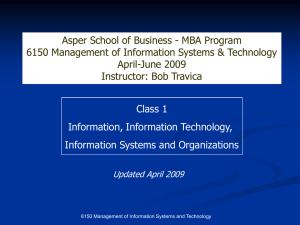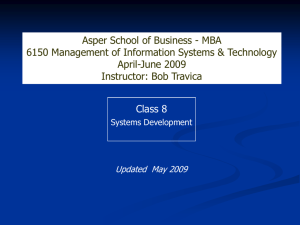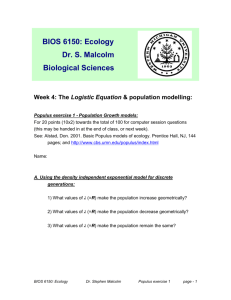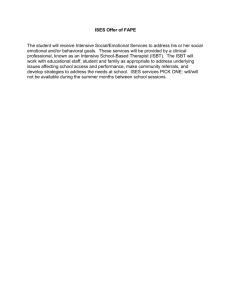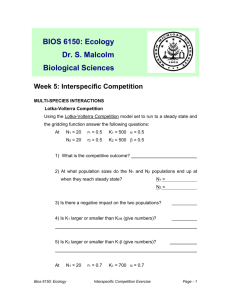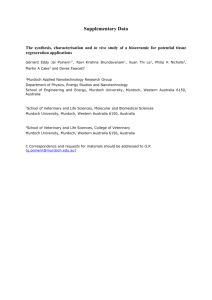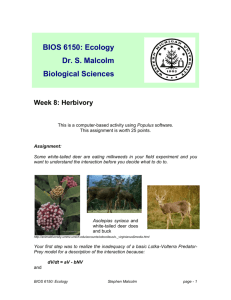Information, IT, IS and Organizations
advertisement
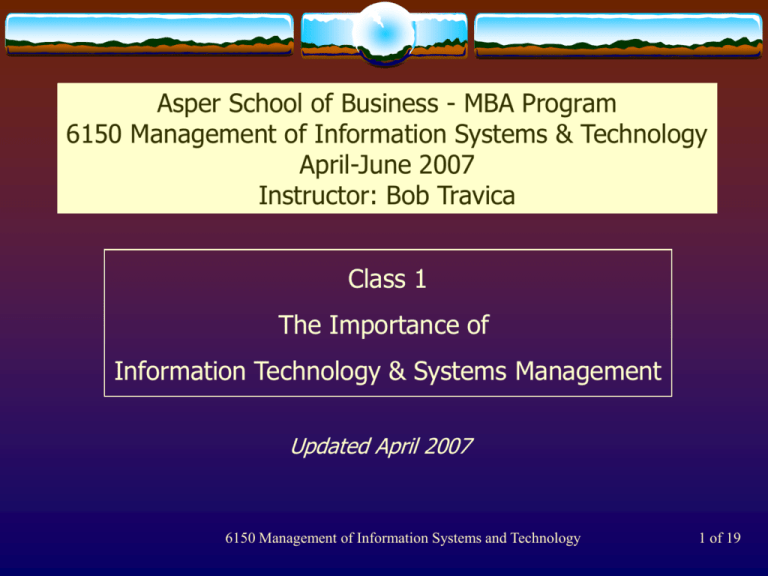
Asper School of Business - MBA Program 6150 Management of Information Systems & Technology April-June 2007 Instructor: Bob Travica Class 1 The Importance of Information Technology & Systems Management Updated April 2007 6150 Management of Information Systems and Technology 1 of 19 Outline • Importance of Management of Information Technology & Systems • Concepts of IT and of IS • What ISes affect your professional life? (practice link, discussion) • Organizational and IS themes & Trends • Historical development of IS function in organizations • Concepts of data, information, and knowledge • Guidelines in study of Management of Information Technology & Systems • Summary 6150 Management of Information Systems and Technology 2 of 19 Importance of Management of Information Technology & Systems • Management of information technology (IT) and information systems (ISes) is similar to “Management Information Systems” (MIS) • Managing IT/IS as a management vehicle for accomplishing organizational goals (strategic perspective) vs. • Managing IT/IS at operational level • IT/IS as asset, “strategic weapon”, tool, “nervous system”, commodity… More… 6150 Management of Information Systems and Technology 3 of 19 • What do we mean by IT? Any tool for manipulating information in broad sense – electronic (computer software and hardware, paper trail) • What do we mean by IS? (see next slide) 6150 Management of Information Systems and Technology 4 of 19 What do we mean by information system (IS)? Information Technology (IT) (Computer & Other* Hardware, Computer Software) Often neglected part Data, IS Use Procedures Information, Knowledge ”Supports” Use Users (Organizational members: Managers, Professionals, Clerks) Task, Process Perform on * Other Hardware = “paper trail” 6150 Management of Information Systems and Technology 5 of 19 Practice link E What ISes affect your professional life? • What do the ISes support? • How do the ISes affect you? • What is good about the systems? • What could be improved? These question can also initiate your thinking about a topic of your paper. 6150 Management of Information Systems and Technology 6 of 19 Contemporary Organizational/IS Themes • Electronic Commerce/Business (Internet, linking back-end systems to Internet interface b/w organization and environment) • Globalization (markets and trade; global computer networks) • Changing perceptions of time (what is “present”; real time data) • Focus on intellectual capital, knowledge (knowledge tech, communication tech.) • Changes in organizations (teams, flattening, any time/any space-operations; groupware, communication tech.) More… 6150 Management of Information Systems and Technology 7 of 19 • Organization webs, alliances, ecosystems (EDI, networks, ERP) • Deregulation, competition, privatization of telecommunications • Demand-Pull (product customization/personalization; support of programmable machinery) • Customer-centric and network-centric business (tech. support) 6150 Management of Information Systems and Technology 8 of 19 Technological Trends • Moore’s Law (IT capabilities double in 17 month-intervals) • Home-grown software, outsourced development (“off-shoring”) off-the-shelf products, Application Software Providers • Proprietary vs. open standards • Internet-centric ISes (storage, distributed services, virtualization) • Systems integration: old/new topic (1980s, ERP systems; intranet) • Wireless & mobile systems 6150 Management of Information Systems and Technology More 9 of 19 Development of IS Function (MeadWestvaco case) - Centralized mainframe data processing centre (1960s) - Decentralization (mini-computers 1970s, PCs 1980s, networks, Client-Server models) - Recentralization (ERP) - Transactions office work decision making professional work - Role of IS function: Support to operations Strategic business partner; interfacing with business and vendors/outsourcing partners; shared IT governance. 6150 Management of Information Systems and Technology 10 of 19 Data, Information, Knowledge • Conceptual Relationships – simple just in textbooks Data Information (Meaningful data, meaning) Knowledge (Complex whole of interconnected information; theories, conceptual maps, procedures, experience) • NOTE: Term “information” also used in broad sense to mean data, meaning (information in narrower sense), & knowledge 6150 Management of Information Systems and Technology 11 of 19 Comparisons low high Complexity, C/B Focus in IS Development Represent knowledge Make data more meaningful (querying, reporting) Store, organize, transform 1950 1970 1990 (but roots older) 6150 Management of Information Systems and Technology 12 of 19 Users Organizational members that use IT, data / information/ knowledge, and IS procedures. Clerks Managers, Professionals 6150 Management of Information Systems and Technology 13 of 19 Guidelines in Study of Management of Information Technology & Systems (Strategic Alignment Model) Professionals, Managers, Clerks Use Provide Requirements Information Technology (Software & Hardware) System Development Data, Information, Knowledge Design & Build Expertise Information System Function Procedures of handling IT and data/information Organizational • Performance • Market Positioning • Design 6150 Management of Information Systems and Technology 14 of 19 Guidelines in Study of Management of Information Technology & Systems (Information View of Organization IVO Framework, IVO Eye) Org. Goals & Issues IVO Eye builds on… 3. Sharper focus on information & IT Individuals 1. Classic org. views Homo Informaticus Org. Processes Work Groups IS Design/Development Group Informatics Org. Structure Infoprocesses DATA MEANING KNOWLEDGE WISDOM IS Use Infostructure INFORMATION TECHNOLOGY IS IS Management Evaluation Infoculture 2. Classic MIS issues IS Adoption Org. Culture Org. Economics Infoeconomics Infopolitics Org. Politics (Travica, 2003, 2005, forthcoming) 4. New aspects at intersection of these three 15 of 19 Summary 1/4 • Managing IT/IS as a management at strategic level is the vehicle (“strategic weapon”, “nervous system”) for accomplishing organizational goals (effectiveness). • Managing IT/IS at operational level (tool) is part and parcel of organizing and performing daily work in efficient manner. • IT refers to machines, devices and simple tools for manipulating data/information. Thus manipulation includes creating, collecting, filtering, storing, organizing, transforming, transferring, and discarding. Examples are computer (our focus), overhead projector, & paper and pencil. 6150 Management of Information Systems and Technology 16 of 19 Summary 2/4 • IS is a whole consisted of IT, system procedures, and data that delivers information (meaningful data). (slide 5) • IS users are important part of MIS (slide 5, 12) • Information and knowledge are often neglected parts while IT is emphasized (a weakness of mainstream MIS textbooks including ours). • By organizing and transforming data, computer contributes to meaningfulness of data. Still, meaning occurs only in human cognition. • Similarly, computer can represent knowledge (e.g., a decision tree in expert systems) but knowledge is only in human brain (slides 5, 11, 12). 6150 Management of Information Systems and Technology 17 of 19 Summary 3/4 • It is useful to think of ISes that affect your professional work, how they impact on you, and what their ups and dons are. This perspective prepares you for this course and for its term paper assignment in particular. - Discussed example: Email systems are part of everyday job and may pose problems, such as email inflation. • Modern IT/IS are involved in key trends of our time, including e-commerce, globalization, changing perceptions of time, and significant changes in organizing (slides 7, 8). • Current technological trends include Internet, Internet-centric systems, and wireless communications. 6150 Management of Information Systems and Technology 18 of 19 Summary 4/4 • The organization of the IS function in firms has moved through several historical stages outlined in MeadWestvaco case (slide 10). • Various analytical models and frameworks can be used for understanding the relationship between IT/IS and organization. - A model for studying IS from a strategic stance (slide 14). - A framework showing relationships b/w organization/management aspects and IS issues (slide 15). 6150 Management of Information Systems and Technology 19 of 19
